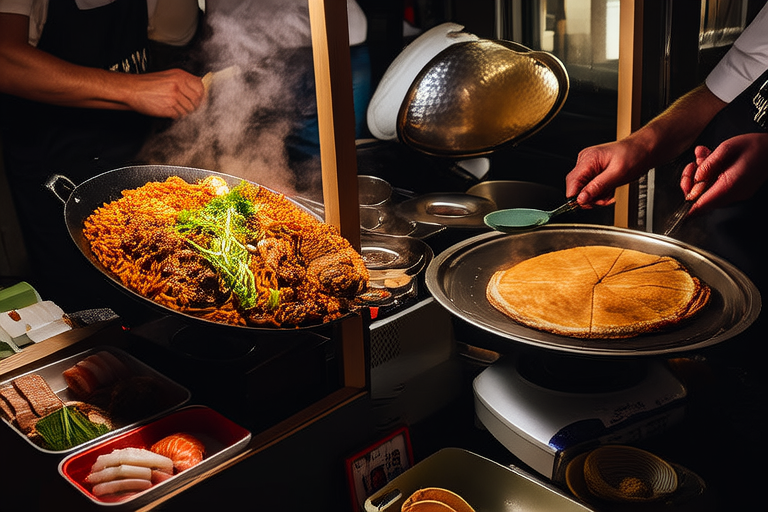Indulge in Global Flavors: Traveling Through Gourmet Destinations

Indulge in Global Flavors: Traveling Through Gourmet Destinations
Introduction
Traveling through gourmet destinations is more than just exploring new places; it’s about immersing oneself in the rich tapestry of global cuisine. Food is an integral part of experiencing different cultures, reflecting the history, geography, and lifestyle of a region. Each dish tells a story, and every ingredient carries its own history. From the precise cuts of sushi in Tokyo to the fiery spices of Indian curries, culinary experiences offer a window into the soul of a place.
Section 1: Europe’s Culinary Gems
France: The Art of French Cooking
France, often referred to as the culinary capital of the world, boasts a rich tradition of gastronomy. Iconic dishes like coq au vin and escargot have been perfected over centuries. Regions like Lyon and Provence are renowned for their culinary prowess. In Lyon, you can sample bouchons, traditional bistros serving hearty, rustic fare. Provence, with its sun-drenched landscapes, is famous for its olive oil, herbs, and fresh produce.
Italy: Regional Cuisines and Fresh Ingredients
Italian cuisine varies greatly by region, each offering distinct flavors and techniques. Naples is synonymous with pizza and pasta, while Lombardy is known for risotto and polenta. The emphasis on fresh, locally sourced ingredients and family recipes is paramount. Traditional dishes like carbonara in Rome and osso buco in Milan reflect the diverse culinary landscape of Italy.
Spain: Tapas Culture and Seafood Delights
Spain’s culinary scene is defined by its tapas culture, where small plates of food are shared among friends. Paella, a rice dish originating from Valencia, is a must-try. Along the coast, seafood reigns supreme, with dishes like patatas bravas and gambas al ajillo being popular. Cities like Barcelona and Madrid offer vibrant culinary experiences, blending tradition with innovation.
Section 2: Asia’s Diverse Palates
Japan: Precision and Seasonality
Japanese cuisine is characterized by its precision and seasonal ingredients. Sushi, ramen, and teppanyaki are staples, each requiring meticulous preparation. Tokyo, as a global culinary hub, offers an unparalleled dining experience. From Michelin-starred restaurants to bustling street food stalls, Japan’s culinary offerings are vast and varied.
Thailand: Bold Flavors and Balance
Thai cuisine is renowned for its bold flavors, with dishes like pad thai, green curry, and mango sticky rice being favorites. The balance between sweet, sour, salty, and spicy elements is key. Street food markets in Bangkok and Chiang Mai offer a taste of authentic Thai flavors, making them must-visit spots for food enthusiasts.
India: Complexity of Spices and Regional Specialties
Indian cuisine is a symphony of spices, with each region offering its own unique specialties. Tandoori chicken, biryani, and dosa are just a few examples. Vegetarianism is prevalent in many parts of India, leading to a wide array of plant-based dishes. The cultural significance of food in Indian festivals, such as Diwali and Holi, further enriches the culinary experience.
Section 3: Americas’ Flavorful Journeys
Mexico: Vibrant Flavors of Street Food
Mexican cuisine is vibrant and full of flavor, with street food playing a significant role. Tacos, mole, and chiles en nogada are just a few examples. The cultural significance of food in Mexican festivals, like Dia de los Muertos, adds depth to the culinary experience. Mexico City and Oaxaca are particularly notable for their culinary offerings.
United States: Diversity of American Cuisine
The United States boasts a diverse culinary landscape, from New England clam chowder to Southern barbecue. The farm-to-table movement is gaining momentum, emphasizing locally sourced ingredients. Fusion kitchens, blending traditional and modern techniques, are also becoming increasingly popular. Cities like New York, San Francisco, and Chicago offer a range of culinary experiences.
Brazil: Hearty Feijoada and Coastal Seafood
Brazilian cuisine is hearty and flavorful, with feijoada, a black bean stew, being a national dish. Coastal regions offer fresh seafood, while indigenous and African influences are evident in dishes like acarajé and moqueca. Rio de Janeiro and Salvador da Bahia are prime locations for sampling Brazilian cuisine.
Section 4: Africa and Beyond
Morocco: Aromatic Spices and Tagines
Moroccan cuisine is distinguished by its aromatic spices and tagines, slow-cooked stews served with couscous. Mint tea is an essential part of the culinary experience, symbolizing hospitality and friendship. Marrakech and Fez are great places to explore Moroccan flavors.
South Africa: Cape Malay Influence and Braai
South African cuisine is influenced by the Cape Malay community, with dishes like bobotie and bredies being popular. Braai, or barbecue, is a social activity that brings people together. Cape Town and Durban are ideal for sampling South African flavors.
Australia and New Zealand: Native Ingredients and Sustainable Seafood
Australia and New Zealand use native ingredients like wattleseed and kangaroo meat, reflecting their commitment to sustainability. Coastal regions offer fresh seafood, while indigenous and Maori influences add unique dimensions to the culinary scene. Sydney and Auckland are great starting points for culinary exploration.
Conclusion
From the artistry of French cooking to the bold flavors of Thai cuisine, each destination offers a unique culinary journey. Whether traveling to these places or trying to recreate these dishes at home, the joy of discovering new flavors is immeasurable. Exploring global cuisine enriches our understanding of different cultures and histories, making it a truly rewarding experience.